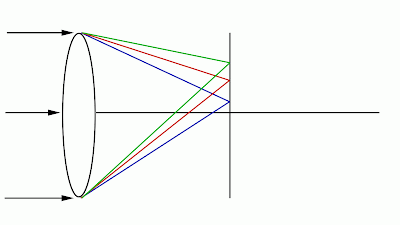 |
| Photo by: frankenschulz |
Chromatic aberration (CA) otherwise known as color fringing or purple fringing appears as unsightly colour fringes near high contrast edges in an image. It is the most varied and complicated lens imperfection, is only visible when the image is viewed at full size in larger screens or in large prints, and is also influenced by the subject matter being photographed.
What is Chromatic Aberration?
Light is composed of rays of different wave-lengths; color is result of its particular wave-length; the speed of the light also varies depending upon its wavelength. Chromatic aberration occurs when the lens is not able to focus different wave lengths of light on to the exact same focal plane. It can also occur when wavelengths of color are focused at different positions in the focal plane.
 |
| Photo by: Leo Reynolds |
Chromatic aberration occurs when the camera lens is not able to focus different wave lengths of light on to the exact same focal plane and/or when wavelengths of color are focused at different positions in the focal plane. Remember different colours of light have different wave lengths and they travel at different speeds. Chromatic aberration may occur due to the fact that focal lengths of different wave lengths are different or due to the lens magnifying different wave lengths differently. The dispersion property of the glass has much to do with determining the amount of chromatic aberration. Due to this phenomenon; images look blurred or with noticeable colored edges (red, green, blue, yellow, purple and magenta) appearing around objects. This aberration is prominent especially in high-contrast situations.
Types of Chromatic Aberrations
Longitudinal or Axial Chromatic Aberration
 |
| Longitudinal or Axial Chromatic Aberration - Different wave lengths are focused at different focal planes. |
Longitudinal chromatic aberration which is also known as ‘bokeh fringing’, occurs when different wavelengths of color do not converge at the same point after passing through a lens. As a result Red, Green, Blue or a mixture of these colors appear around objects. Typically fast prime lenses are more prone to longitudinal chromatic aberration than slower lens. This problem can be minimized by stopping down the lens.
 |
| Photo by: Reinhold Stansich |
Lateral Chromatic Aberrations
 |
| Lateral or Transverse Chromatic Aberration - Lens magnifies different wave lengths differently. |
Lateral Chromatic Aberration, also known as ‘transverse chromatic aberration’, occurs when different wavelengths of color coming at an angle focus at the same focal plane but at different positions. It appears as opposing dual color fringing of cyan/magenta with a blue/yellow; lateral chromatic aberration is more pronounced towards the corners of the image. Unlike Longitudinal Chromatic Aberration, stopping down the lens does not eliminate Lateral Chromatic Aberration.
Sensor Blooming
 |
| Photo by: Bruce Thomson |
Sensor blooming is usually found in high resolution compact cameras and some older versions of the same; it appears as blue or purplish color fringing which occurs due to spill over highlight clipping occurring at sensor level. Mostly found with sharp, clipped specular highlights e.g. foliage against blown out sky. Sensor blooming is more apparent when the image is viewed at higher resolutions and is usually un-correctable.
Correcting Chromatic Aberrations
 |
| Photo by: Herve BRY |
Chromatic aberrations (C As) spoil image sharpness up to huge extends and reducing it could greatly improve image quality. All types of chromatic aberrations cannot be removed and some of them can only be reduced. Some of the blooming and axial CA will remain in most cases. Photographing true light sources like stars in the night or direct reflections off metal or water may cause aberrations that are hard to be removed. We will discuss about removing distortions in post production in detail in a future article.
Post a Comment